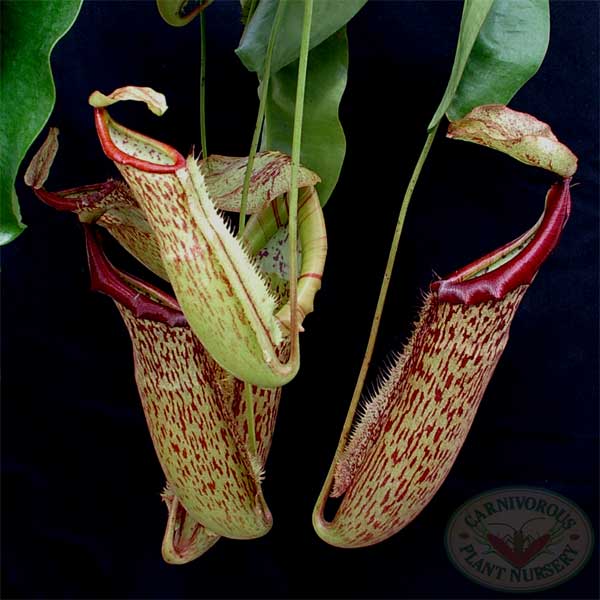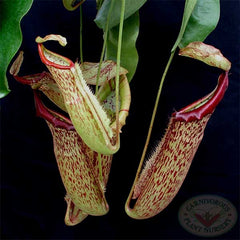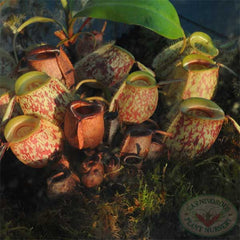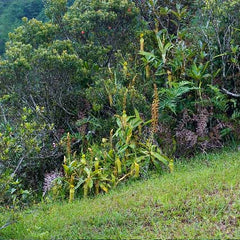
Nepenthes
Tropical Pitcher Plants
Nepenthes are climbing carnivorous plants with impressive hanging pitchers that are the largest of any carnivorous plants. They are native to tropical Southeast Asia, and come in many varieties. Each trap is actually a modified carnivorous leaf, a pitfall trap, with bottoms filled with digestive fluid.
Many are on the endangered species list. They are a very diverse group of plants with over 300 species, each with small growing ranges, sometimes only certain islands, mountains or ridges. Their greatest diversity is in the Malay Archipelago. Their tropical habitat ranges from cool mountain highlands to warm sea level rainforests. As a group, Nepenthes are divided into "Highland" and "Lowland" species, differentiated by growing above or below 3300 feet (1000 m). Carnivorous Plant growers with cooler growing conditions, especially in the winter, may have greater success with Highland varieties. Carnivorous Plant growers who can keep warmer winter conditions might prefer the Lowland types. Highland species tend to grow fewer traps, but they are more long lasting and sturdier than typical Lowland species. There are Intermediates and they are usually good growers for either winter type. They typically grow in the open, sunny areas, climbing up shrubs and trees, or in open grasslands. The soils are generally acidic and low in nutrients, sandy, volcanic and peaty.
Their traps are great at luring, catching and digesting a large number of insects. Though the traps are passive (no moving parts), they actually catch more insects than any other carnivorous plant. Their larger than average trap sizes become an inescapable pitfall for many insects including: stink bugs, yellow jackets and wasps. They look and function much like those of the American Pitcher Plants, Sarracenia, but their carnivorous traps form on tendrils coming from the mid vein of each leaf. In their natural habitat, the pitchers are 20-30% filled with digestive fluids, secreted from the plant, and diluted by rain water. Their colors can be quite amazing, often with reds and speckles. There can be 2 distinct shapes/colors of traps on a single plant: basal and upper traps. Basal traps, (sometimes called terrestrial or ground pitchers), form on young plants, when the plants tend to be rosettes near the ground. They are generally more bulbous and darkly colored with prominent wings. Upper pitchers form on mature stems after 2 to 4 years, when the plant is in the vining stage. They are generally smaller, funnel shaped, with small or no wings. The largest leaf blades usually grow right before vining occurs, when the leaf blade then get progressively smaller with each new leaf. Most tubes are about hot dog size, some like N. x miranda have traps longer than my forearm. Their prey is usually insects, but snails, rats and frogs are more unusual.
Nepenthes are lianas, (climbing vines) and can be long lived with traps increasing in size with age. Living for decades is not unusual. They are dioecious, that is, there are separate male and female plants. They are sometimes called Monkey Cups or Asian Pitcher Plants. They were the second group of plants to be identified as carnivorous. The first was the Sarracenia. There is an early woodcut of nepenthes from 1696. They became the rage of horticulture in Victorian hot houses, when great ship expeditions went worldwide in search of the wonderful diversity of nature. Antique prints from this era are available.
Nepenthes are typically propagated from cuttings, and seed, but it can take a while to get a good size plant, even years. Tissue culture is another common propagation technique, especially of interesting clones. Nepenthes should be repotted with fresh soil mix every few years.



 |
 |
 |
| "Utricaria vegetables zeylanensium" (Nepenthes distillatoria) 1696. | N. sanguine from Paxton's Glower Garden, Vol. 1, Plate 9, 1882. | N. rafflesiana from VanHoutte, Flore Serres des Jardins de l'Europe, Vol 3, Plate p.213, 1847. |

